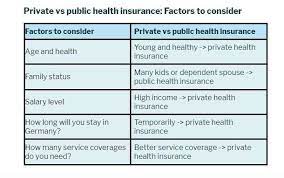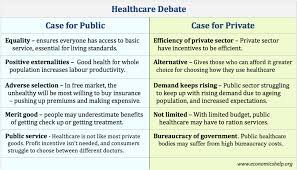Choosing the right health insurance is a crucial decision that can affect your financial stability and access to healthcare services. In many countries, individuals have the option to choose between public (government-funded) and private health insurance plans. Each option comes with its own set of advantages and disadvantages. This article provides an overview of public and private health insurance, comparing their features, benefits, and potential drawbacks.
 1. Understanding Public Health Insurance
1. Understanding Public Health Insurance
Overview
Public health insurance is typically funded and administered by the government. It aims to provide affordable healthcare coverage to all citizens, ensuring access to essential health services.
Key Features
- Universal Coverage: Public health insurance often aims to cover all citizens, regardless of income or health status. This universal access helps reduce health disparities.
- Cost-Effective: Generally, public plans have lower premiums and out-of-pocket costs compared to private insurance, making healthcare more affordable for individuals and families.
- Standardized Benefits: Public health insurance typically offers standardized benefits, ensuring that all enrollees receive a core set of services, such as preventive care, hospital stays, and emergency services.
Advantages
- Accessibility: Public insurance programs often provide services to underserved populations, ensuring that everyone has access to necessary care.
- Reduced Administrative Costs: With fewer administrative overheads, public health insurance can often deliver services at a lower cost.
Disadvantages
- Long Wait Times: Public systems may face challenges with wait times for non-emergency services, as demand often exceeds supply.
- Limited Provider Choices: Patients may have fewer options regarding healthcare providers and specialists compared to private insurance plans.
2. Understanding Private Health Insurance
Overview
Private health insurance is provided by private companies and can be purchased individually or through employers. These plans often offer more personalized options and flexibility.
Key Features
- Variety of Plans: Private insurance offers a wide range of plans to choose from, allowing individuals to select coverage that fits their specific needs and preferences.
- Faster Access to Care: Private insurance often provides quicker access to services, including elective procedures and specialist care.
- Customized Benefits: Many private plans allow for customization, enabling consumers to choose additional coverage options, such as dental, vision, and alternative therapies.
Advantages
- Greater Flexibility: Private insurance often offers more flexibility in choosing healthcare providers, including access to specialists without referrals.
- Shorter Wait Times: Patients with private insurance may experience shorter wait times for appointments and procedures.
Disadvantages
- Higher Costs: Premiums, deductibles, and out-of-pocket costs for private insurance can be significantly higher than those for public plans, potentially leading to financial strain.
- Complexity: The variety of options available can make it challenging to navigate private insurance plans, leading to confusion about coverage and costs.
3. Comparative Analysis
Cost
- Public Insurance: Generally more affordable, with lower premiums and out-of-pocket expenses.
- Private Insurance: Higher costs, but with potential for more comprehensive benefits and faster access to care.
Access to Care
- Public Insurance: Universal access, but may involve longer wait times and fewer choices.
- Private Insurance: Greater provider choice and faster access, but not universally available to all individuals.
Quality of Care
- Public Insurance: Quality can vary, but programs aim to provide essential services to all.
- Private Insurance: Often perceived to offer higher quality due to competition among providers, but quality can vary widely between plans.
4. Making the Right Choice
Assessing Your Needs
- Personal Health Status: Consider your current health needs and any chronic conditions that may require ongoing care.
- Budget Considerations: Evaluate your financial situation and how much you can afford to spend on health insurance premiums and out-of-pocket costs.
Evaluating Options
- Research Plans: Look into both public and private options available in your area. Compare premiums, coverage, and network providers.
- Consult Professionals: Speak with insurance agents or financial advisors to understand the implications of your choices and to help navigate complex options.
 Conclusion
Conclusion
Choosing between public and private health insurance is a significant decision that depends on individual circumstances, health needs, and financial situations. Public health insurance offers universal coverage and affordability, while private insurance provides flexibility and quicker access to care. By understanding the key differences and evaluating personal needs, individuals can make informed choices that best suit their healthcare requirements and financial capabilities. Regardless of the option chosen, the ultimate goal remains the same: to secure access to quality healthcare services when needed.


